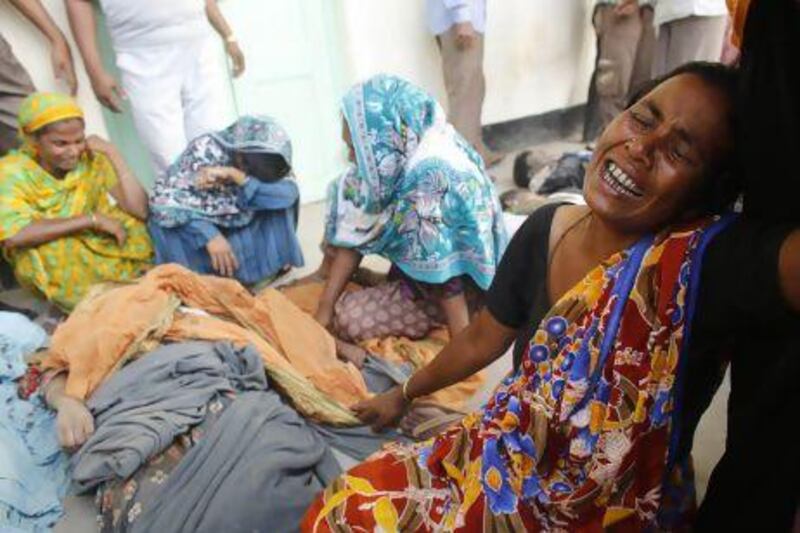SAVAR, Bangladesh // With deep cracks visible in the walls, police had ordered the building to be evacuated the day before its deadly collapse - but clothing factories flouted the order and told more than 2,000 people to go inside and keep working, officials said yesterday.
More than 200 people died when a huge section of the eight-storey Rana Plaza crumbled into a pile of concrete slabs on Wednesday.
The disaster, in the Dhaka suburb of Savar, came less than five months after a blaze at a clothing factory in Ashulia, another suburb, killed 112 people.
The tragedies have underscored the unsafe conditions faced by those who work in Bangladesh's garment industry making clothes for well-known brands worn around the world. Some of the companies in the building that collapsed said their customers included retail giants such as Wal-Mart.
Hundreds of rescuers, some crawling through the maze of rubble in search of survivors and corpses, worked through the night on Wednesday and into yesterday amid the cries of the trapped and the wails of relatives gathered outside the building, which housed several clothing factories and a handful of other companies.
Dozens of workers were found alive in the ruins yesterday, a rare success for rescuers who have pulled out 250 bodies.
An army spokesman initially announced that 40 survivors had been discovered together in a room, but the figure was revised to 24.
"The death toll is now 250," said Moshiuddowla Reza, a senior police officer from Dhaka district.
More bodies were being recovered and most of those who had died were women who worked in the clothing factories, he added.
After the cracks were reported on Tuesday, managers of a local bank that had an office in the building evacuated their workers.
But the garment factories ignored the instructions of the local industrial police and told their employees to go inside and keep working, said Mostafizur Rahman, a director of that paramilitary police force.
The Bangladesh Garment Manufacturers and Exporters Association had also asked the factories to suspend production on Wednesday morning, just hours before the collapse.
"After we got the crack reports, we asked them to suspend work until further examination, but they did not pay heed," said Atiqul Islam, the group's president.
The garment manufacturers' group said the factories in the building employed 3,122 workers, but it was not clear how many had been in the building when it collapsed.
The junior minister for home affairs, Shamsul Haque, said that 2,000 people had been rescued by yesterday morning.
Dozens of bodies, their faces covered, were laid out beside a school for their families to identify them.
Thousands of relatives gathered outside the building, waiting for news, as thousands of workers from nearby clothing factories took to the streets across the industrial zone in protest.
Abdur Rahim, an employee who worked on the fifth floor, said a factory manager had given assurances that the cracks in the building were not a cause for concern, so employees went inside.
"After about an hour or so, the building collapsed suddenly," Mr Rahim said. The next thing he knew, he was waking up outside.
During a visit to the site, the home minister, Muhiuddin Khan Alamgir, said the building had violated construction codes and that "the culprits would be punished".
Abdul Halim, an official with the engineering department in Savar, said the owner was given permission for a five-storey building but had added three storeys illegally.
The local police chief, Mohammed Asaduzzaman, said police and the government's Capital Development Authority had filed separate cases of negligence against the building's owner.
Habibur Rahman, the police superintendent of Dhaka district, identified the owner of the building as Mohammed Sohel Rana, a local leader of the ruling Awami League party's youth front. Mr Rahman said police were also looking for the owners of the garment factories.
The collapse was even deadlier than the Tazreen factory fire in November that drew international attention to working conditions in Bangladesh's US$20 billion [Dh73.46bn] clothing industry.
That building had lacked emergency exits, and its owner said only three floors of the eight-storey building were built legally. Survivors said gates were locked and managers told them to go back to work after the fire alarm went off.
Bangladesh has about 4,000 garment factories and exports clothes to leading western retailers. The industry wields vast power in the South Asian nation.
* Associated Press, with additional reporting by Agence France-Presse






